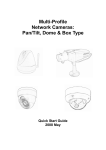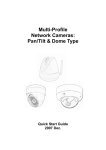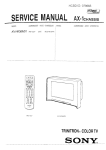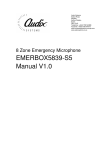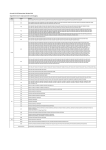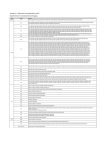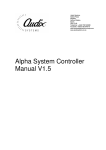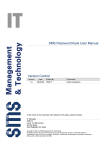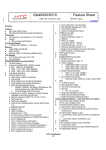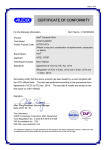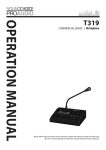Download SMU Serial Microphone Unit
Transcript
* + ----- !" #$% & '' ( $) )) !" #$ % & '' ( , ) + + . + + / Serial Microphone Unit (SMU) 8 & 16 Button Versions User Manual V2 SMU 8/16 User Manual 1. Revision History Version A B 1.0 1.01 1.02 2 Modifications Original issue. File renamed from dmic-006.doc Wiring diagram changed to show new type factory fitted cable PSF10/2 Add BGM selection mode to Appendix 3 Re-Formatted Version New section ‘Safety Considerations’ replaces Appendix 3 Appendix 1 split to a separate document. Add to spec. freq.resp and s/n ratio Add SMU16 and drawings Date 15/4/99 20/5/99 6/7/99 23/7/99 6/10/00 CN3311 18/01/02 10/3/04 © Copyright Audix Systems. 2005 DISCLAIMER This manual contains information that is correct to the best of Audix Systems knowledge. It is intended to be a guide and should be used as such. It should not be considered as a sole source of technical instruction, replacing good technical judgement, since all possible situations cannot be anticipated. If there are any doubts as to exact installation, configuration and/or use, call Audix Systems at +44 (0)1799 540888 ACKNOWLEDGEMENTS All trademarks are recognised page 2 of 14 21004 SMU8 and 16 V2.doc SMU 8/16 User Manual 2. Table of contents 1. 2. 3. 4. 5. Revision History............................................................................................................2 Table of contents ..........................................................................................................3 Product Description ......................................................................................................4 SMU8 Specifications.....................................................................................................5 Paging Microphone Operating instructions ...................................................................7 Used with Alpha ...............................................................................................................7 Using SMU8 with a Vector or V32 based system.............................................................7 Using SMU8 to make programme changes to a Vector system. ......................................8 6. Background Music Controller (BGM) ............................................................................8 Operation Music broadcast...........................................................................................9 7. Installation instructions .................................................................................................9 Wiring. ..............................................................................................................................9 Fixed Installation Cable types. .........................................................................................9 8. Setting Up...................................................................................................................10 Connector pin-outs and Jumper settings........................................................................11 9. Safety Considerations.................................................................................................14 10. Glossary of terms ....................................................................................................14 page 3 of 14 21004 SMU8 and 16 V2.doc SMU 8/16 User Manual 3. Product Description The SMU8/16 is desk mounted microphone console for primarily designed for use with Audix Systems Public Address and Voice Alarm controllers. The unit features eight ore sixteen “selection” buttons which are typically used to select zones or groups of zones ready for spoken announcement. A ninth (17th) button is the press-to-talk key, which used by the operator to make a call. A “speak-now” indicator is associated with this button. Led indicators provide comprehensive status display. Red LED’s showing when zones are busy, green LED’s show when calls are successful. Customers button designations can be added on smart printed labels behind a glass window above the selection buttons. The unit features a good quality dynamic microphone and a low noise pre-amp with balanced input. Maximum intelligibility is maintained with a combination of digitally controlled pre-amp gain, and dynamic gain adjustment (compressor-limiter) in the digital domain. An optional LED indicator shows that when the user is talking at or above the limiter threshold. A digitally synthesized 20kHz monitor tone for the Audix Systems FMS is injected directly at the microphone head, with innovative circuitry able to detect open or short circuit failure of the microphone. The microphone console features a choice of 2 or 3 built in pre announcement chime signals. There is independent adjustment for the chime volume. Audix Systems may offer a service to customise an SMU8/16 with high quality digitally recorded pre-announcement tones to customer requirements. Some features of the SMU816 may not be supported by the PA control equipment that the SMU8/16 is used with. Due to continued development, Audix Systems reserves the right to change any of the operational features of the SMU8/16 described in this document. page 4 of 14 21004 SMU8 and 16 V2.doc SMU 8/16 User Manual 4. SMU8 Specifications. Power supply voltage range Supply current (max. inrush) Supply current (typical) Audio output nominal Audio output max. Output impedance Load impedance Distortion T.H.D. Signal to Noise ratio Peak overload indicator threshold Audio sampling rate a-d and d-a resolution Pre-announcement chimes 1,2,3, total duration Data link Baud rate Frequency Response (Mic head) Microphone gain trim range Microphone gain reduction in idle (survey) state 20 – 35V d.c.. 500mA 110mA @ 24V 0dBu +10dBu < 50 ohms > 600ohms < 0.05% 55dB 0dB or >2dB limiter gain reduction 48kHz 16 bits 5 seconds RS485 half duplex 9600 150Hz-7kHz (+3dB) 20dB -22.5dB Surveillance tone adjustment range Surveillance tone adjustment resolution Surveillance tone stability -20dBu – -50dBu 3dB o 100ppm/ C Operating temperature range Max Humidity EMC operating environment (As defined by EN50081-1, EN50082-1) Manufactured to Safety Standard 0 – 40 C 85% non-condensing Domestic, Commercial, Light Industrial. EN60065:1998 o The unit is connected to the PA system via a three or four pair cable. Pair 1: The unit is powered from a nominal 24V D.C. supply. Pair 2: Data COMM’s is by a RS485 half duplex link running at 9600 baud. Pair 3: Audio output from the unit is at balanced line level audio 0dBu nominal. Pair 4: (Optional) for driving 2 auxiliary indicator LED’s. Each pair should be individually screened, with a common overall screen connected to earth. page 5 of 14 21004 SMU8 and 16 V2.doc SMU 8/16 User Manual Zone Selection Microphones page 6 of 14 21004 SMU8 and 16 V2.doc SMU 8/16 User Manual 5. Paging Microphone Operating instructions Used with Alpha 1. Ensure the Power LEDs are lit 2. Each zone selection button has a Red BUSY and a GREEN Confirm light associated with it. 3. If the operator presses a zone select button the green CONFIRM light shine constantly (NOTE that the zone is not connected until the PTT is pressed). 4. When the operator press their PTT the zone is connected, the green confirm light stays lit and the Speak (Green) indicator is lit. 5. Make the broadcast. The microphone panel has a pre-amplifier co-located in the room which utilises a compressor/limitter cicruit. This boosts a quiet voice and limits a loud voice to enable consistent loudness of broadcasts 6. If the operators speaks too loudly the red triangle “Overload” indicator flashes 7. Release the PTT. 8. All indicators go out. 9. If a zone is BUSY the corresponding RED indicator is lit constantly. 10.If the operator selects a zone which is Busy (not recommended) due to a higher or equal priority user accessing the zone the Confirm light initially comes on continually. However, when the PTT is pressed the Confirm light flashes indicating the operator is being over-ridden and therefore not making a broadcast. 11.If the operator is of a higher priority than the user already on the system the green Confirm light comes on constantly and a broadcast can be made (over-riding the current user). Using SMU8 with a Vector or V32 based system. When the SMU8 is idle it will show red LED’s on each button where a zone or zones that the button may call is busy. When you wish to make an announcement, the first step is press the buttons that are labelled with the zone names you wish to call, this is called selecting the zones. A green LED will light by each button to show that it has been selected. Any selection may be cancelled by pressing the button again. When the selection has been made the next action by the announcer is to press and hold the PTT or speak button. Until this point announcer has had no effect on the PA system. Once the PTT is pressed the pattern of LED’s changes to show green for the zones that are reached by the call. A rapidly flashing green LED by the speak button, indicates that the pre-announce chime is active and the announcer should wait until this green LED stays solidly on. This is the Speak-now indication. page 7 of 14 21004 SMU8 and 16 V2.doc SMU 8/16 User Manual Whilst holding the PTT button, the announcer should then talk steadily and clearly into the microphone with their mouth about 10 to 20 cm. from the microphone head. The call ends when the announcer releases the PTT button, thereby turning off the microphone, indicated by the Green LED’s turning off. The SMU8 reverts to showing red LED’s for busy states of all the zones programmed on its buttons. Note that when a selection is started only the busy LED’s on the selected zones are shown. This feature, called “selections-busy ” makes it easier for a caller see when his call zones become free. Using SMU8 to make programme changes to a Vector system. The SMU8 must be switched to PMCV compatible mode to achieve this. Remember to switch back to the normal SMU8 mode after programming is completed. 6. Background Music Controller (BGM) The panel is available as an 8/16 button background music controller. The unit is supplied without a microphone in both desk top and rack mounted formats. The units can be used for routing music sources to specified zones. Rack Mount page 8 of 14 21004 SMU8 and 16 V2.doc SMU 8/16 User Manual Operation Music broadcast 1. Ensure the Power LEDs are lit 2. Each selection button has a GREEN Confirm light associated with it. 3. If the operator presses a button the green CONFIRM light shine constantly and the music is broadcast to the selected zones 4. The music is stopped when the selection button is re-pressed. 5. All indicators go out. 6. If the operator selects a zone which is Busy (not recommended) due to a higher or equal priority user, the Confirm light flashes indicating that the operator is being over-ridden and therefore not making a broadcast. 7. Installation instructions Warning: Upon first connection of the SMU8 to a system, the initial setting of the 20kHz surveillance tone should be set very low or turned off. This will avoid damage to loudspeakers and amplifiers by the inaudible tone in the event that system volume controls are set very high. Wiring. The SMU8/16 will normally be located on a desk or table, but is permanently wired into a junction box or wall box using the single flexible multicore cable provided. Wiring from the junction box to the main systems equipment may be made with different cable types, depending on the environment and the length of the cable run. In any case the cable should be individually screened pairs, with an over-all screen which must be earthed. Fixed Installation Cable types. Care should be taken when installing microphone cabling with respect to other power cables and systems likely to cause interference e.g. Mains cabling, Motors etc. In its normal operational mode the unit is supported on a 3 pair cable. Depending on the installation there may be a requirement to use fire resistant or LSF cables. Audix Systems can offer advice, based on previous experience as to suitable cable types and maximum cable lengths. page 9 of 14 21004 SMU8 and 16 V2.doc SMU 8/16 User Manual 8. Setting Up. There are a number of pre-set controls that must be set during system commissioning. The location of these controls is shown in the figure below. Use the channel gain control on the PA system to adjust the volume of the microphone. Do not adjust the “mic pre-set gain control” which has been factory set to match the characteristics of the microphone, and will not normally be adjusted on site. The “mode control” will normally be set for SMU Basic Mode (E), unless the unit is being used to program a Vector (F). See the table in section ‘Connector pin-outs and Jumper settings’ for other modes. The “chime switch” will be set to select the required chime. It is also used to adjust the chime volume after the mic volume has set on the PA system. To turn the chime off completely select Position 0 on this switch. page 10 of 14 21004 SMU8 and 16 V2.doc SMU 8/16 User Manual Connector pin-outs and Jumper settings Main system connection: 10W Terminal Block. PL1 Pin Signal name Signal description 1 0V Power supply return and ground connection. 2 +24V +24V nom. (20 to 35V) d.c. power supply input. 3 OP+ Audio signal +ve 4 OPAudio signal –ve 5 LD1 Active low to light Auxiliary green LED 6 CEN Active low to enable chime in PMCV compatible mode 7 LD2 Active low to light Auxiliary yellow LED 8 D+ RS485 data +ve 9 DRS485 data –ve 10 0V. Screen connection for data pair. Jumper links on the D780 PCB. The following jumpers are used to set the card up for different applications, the table below shows how they will normally be set at the factory for the SMU8. J6 (Fit 2-3) Selects the Serial output to the LED’s on the PCB or to the expansion connector PL2 J7 (Fit 1-2) Selects the serial input from the switches on the PCB or from the expansion connector PL2 J2 Do not fit. Used for Flash boot ROM option. J3 Do not fit. Used for Flash boot ROM option. J4 Fit. Card uses boot EPROM 27C040. J5 Fit (1-2). Card uses boot EPROM 27C040. J1 Do not fit. Used as reset on factory test. page 11 of 14 21004 SMU8 and 16 V2.doc SMU 8/16 User Manual Preset controls. Figure shows the pre-set controls which are accessible behind a metallic label below the front edge of the front panel. These controls will be set up during installation using the above information. They should not be adjusted with out an understanding of the effects on the Public Address or Voice Alarm system. Setting not listed in the table may cause the SMU8 to function unpredictably. Mode Switch settings D E F BGM selector mode SMU8 basic mode PMCV compatible mode for Vector Programming. From V1.02 All versions From V1.01 Chime Switch settings 0 4 5 6 7 8 9 A B C D E F Disable chime Chime 1 Volume min. Chime 1, louder. Chime 1, louder still. Chime 1 Volume max. Chime 2 Volume min. Chime 2, louder. Chime 2, louder still. Chime 2 Volume max. Chime 3 Volume min. Chime 3, louder. Chime 3, louder still. Chime 3 Volume max. 20kHz Switch settings 0 1 x F No surveillance 20kHz minimum output level. Increasing by 3dB steps 20kHz maximum output level page 12 of 14 21004 SMU8 and 16 V2.doc SMU 8/16 User Manual Wiring diagrams: Wiring of factory fitted cable. Note that three-pair cable may be used for systems where no auxiliary LED indicators are required. (A chime-enable wire is not normally required.) The supplied cable is 2 metres long, which may be extended using cable of a similar type. Wiring of cable used on PMCV8 & 16 (Vector microphones) and early SMU models. page 13 of 14 21004 SMU8 and 16 V2.doc SMU 8/16 User Manual 9. Safety Considerations. Review the following safety precautions to avoid injury and prevent damage to the product. The product should only be used as specified. The SMU8 should be operated from a suitable DC supply of nominally 24V. Use only the correct power source, which must contain current overload protection to protect the wiring between the system and the SMU8. Do not disconnect the cable from the product whilst the Voice Alarm system is powered. Do not operate in wet or damp conditions or expose to dripping or splashing. Do not operate in an Explosive Atmosphere This product may be incorporated into a Monitored Voice Alarm system. If so, to tamper with any of the setting of the SMU8 unit may cause a Fault Condition warning on the Voice Alarm control unit. In these circumstances the restoration of normal operation of the system may not be possible without access to the Main Voice Alarm Equipment by qualified personnel. 10. Glossary of terms FMS Fault Monitoring System: Audix Systems BS5839 compliant monitoring system, integrated into all Audix Systems Voice alarm components. SMU Serial-link Microphone Unit. Audix Systems microphone console with a serial data link between its control buttons and the Voice Alarm or Public Address system. PMCV Serial-link Microphones originally used with Audix Systems Vector and V32. page 14 of 14 21004 SMU8 and 16 V2.doc














